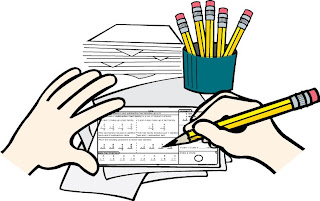 Excel Math uses unique paper student lesson sheets instead of technology or keyboarding to help students learn and write the math concepts. The lessons do not include busy work, since the students don't need to copy over the entire problem. Instead, students form shapes, numbers and number words by hand as they complete the worksheets. Brain research supports that students retain more in the long term when they actually write it down.
Excel Math uses unique paper student lesson sheets instead of technology or keyboarding to help students learn and write the math concepts. The lessons do not include busy work, since the students don't need to copy over the entire problem. Instead, students form shapes, numbers and number words by hand as they complete the worksheets. Brain research supports that students retain more in the long term when they actually write it down. According to a Wall Street Journal article by Gloria Bounds, "Using advanced tools such as magnetic resonance imaging, researchers are finding that writing by hand is more than just a way to communicate. The practice helps with learning letters and shapes, can improve idea composition and expression, and may aid fine motor-skill development." Perhaps that's one reason why Excel Math is used successfully for remediation as well as for advanced students. Actually writing the answers by hand, along with our unique spiraling system is helping students remember the math and recall it over the long term.
According to a Wall Street Journal article by Gloria Bounds, "Using advanced tools such as magnetic resonance imaging, researchers are finding that writing by hand is more than just a way to communicate. The practice helps with learning letters and shapes, can improve idea composition and expression, and may aid fine motor-skill development." Perhaps that's one reason why Excel Math is used successfully for remediation as well as for advanced students. Actually writing the answers by hand, along with our unique spiraling system is helping students remember the math and recall it over the long term."Other research highlights the hand's unique relationship with the brain when it comes to composing thoughts and ideas," the article continues. "Virginia Berninger, a professor of educational psychology at the University of Washington, says handwriting differs from typing because it requires executing sequential strokes to form a letter." Read more from the article: How Handwriting Boosts the Brain
Excel Math lets students begin drawing (writing) numerals in Kindergarten and First Grade. We believe that physically creating the shapes (playing with counting blocks, using counters and manipulatives, etc.) is critical in developing a deep understanding of mathematics. There is a hand-eye-brain coordination/connection that is reinforced by actual physical activity of creating the numerals in an answer (as opposed to clicking on the correct answer on the screen).
Here's a third grader's Excel Math Lesson Sheet ... [click the image to enlarge]
 |
| Completed Grade 3 Excel Math Lesson Sheet |
New to Excel Math? Preview elementary math lessons that really work for Kindergarten through Sixth Grade on our website: www.excelmath.com.
Download sample lessons from our new Common Core Teacher Editions at http://excelmath.com/downloads/state_stds.html


No comments:
Post a Comment
Type your comment here